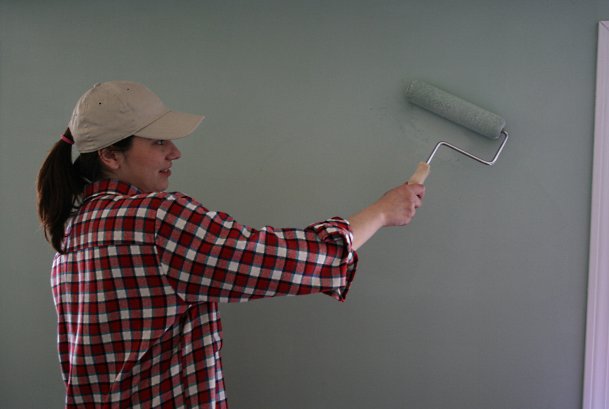Few modern paints created with synthetic materials can truly claim to be VOC-free. Old-fashioned paint formulas created with natural pigments and binders are surprisingly durable and attractive. These non-toxic paint alternatives are especially good choices when a resident has asthma, chronic disease, or severe allergies; in areas where children and pets will spend a lot of time; and when the most ecologically conscious product is desired. Old-fashioned paints can be divided into a few main subgroups.
Whitewash
Whitewash is a combination of water, lime, and salt. Although it gets its name from the natural white color of the lime, whitewash can actually be tinted different colors by adding minerals. Yellow ochre produces a creamy yellow, iron oxide creates a dull red, and lampblack a soft gray. Don’t expect opaque coverage with whitewash. It acts more like a stain, lightening and brightening wood without obscuring its grain. Whitewashed objects take on an old-fashioned, weathered charm. Whitewashing provides a small degree of protection against bacterial and fungal growth.
Whitewash recipe:
- 12 cups lime
- 4 cups salt
- 2 gallons water
Combine lime and salt. Add mixture to warm water, stirring constantly. Mixture will be thin. Allow to rest overnight, stir again, and use.
To improve durability, you can mix in:
- 2 tablespoons powdered alum OR
- 1/2 cup hide glue flakes OR
- 1/2 gallon skim milk
Whitewash is applied with a broad, flat brush and applied liberally. Don’t worry if it’s not thick like paint- it isn’t supposed to be. The covered area will get lighter as the whitewash dries. Whitewash cleans up easily with water.
Milk Paint
Milk paint is dead flat, quite durable and can be vibrantly colored. Its finished appearance is comparable to many modern flat paints. This is, by far, the most commonly used all-natural paint today. The wet paint has a similar texture to latex formulas and is easy to work with.
Milk paint recipes range from extremely simple to relatively complicated. Lime makes a more stable paint, Plaster of Paris helps create a more durable finish, and quarking (described in recipe 4) results in a stronger, more durable paint that is resistant to mildew.
Milk Paint Recipe #1:
- 10 cups nonfat dry milk
- 10 cups warm water
- Vegetable dye, food coloring, or powdered pigment
Thoroughly combine milk and water. Continue stirring till all the milk powder is completely absorbed. Add colorant, a little at a time, until the appropriate hue is achieved. If you think you may have to mix a second batch, measure out your colorant and take notes; just keep in mind that you still might not achieve consistent results.
Milk Paint Recipe #2:
- 12 cups skim milk
- 1 cup lime
- Vegetable dye, food coloring, or powdered pigment
Thoroughly combine milk and lime. Add coloring to achieve desired shade.
Milk Paint Recipe #3
- 1-1/2 cups skim milk
- 3 tablespoons lime
- 2-1/4 cups plaster of paris
- Vegetable dye, food coloring, or powdered pigment
Thoroughly mix milk and lime. Add plaster of paris and stir to combine. Add pigment to reach desired color.
Milk Paint Recipe #4
- 1 gallon skim milk
- 2 cups white vinegar or lemon juice
- 3/4 cup hydrated lime
- 1-3/4 cup dry pigment powder
- 1-3/4 cup + 1-1/2 cup water
Combine milk and vinegar. Allow to rest until the milk solids separate from the watery whey. A warm room will help things along, but keep the mixture under 115 degrees F to preserve the casein (milk protein).
Meanwhile, combine pigment and 1-3/4 cups water and stir thoroughly to combine.
Place lime in a separate container and slowly add 1-1/2 cups water to form a smooth paste. Be careful! Don’t inhale the dust or get it on your eyes or skin- it’s very irritating.
Line a colander with cheesecloth and use it to strain the milk mixture. Discard the whey and rinse the remaining curds with clear water. Allow to drain, then transfer the remaining material, called “quark,” into a large, clean container.
Stir the lime paste into the quark. The curds should dissolve easily. The base is ready when the mixture looks and feels like heavy cream. At this point you can add the moistened pigment until you create a pleasing color.
Strain milk paint before using (sometimes lumps of quark or lime remain), and use while still fresh.
If you like the idea of milk paint, but not all the work, Old Fashioned Milk Paint is a New England manufacturer that carries 20 different colors. The product is shipped as a dry powder and needs to be mixed with water before painting.
Flour Paint
Paints created with wheat flour are thick and can be difficult to spread. They work well for creating unusual textures, and faux finishes. This type of paint is versatile; it can be used for both interior and exterior applications.
Flour Paint
(Recipe from Mother Earth News)
- 1 cup flour
- 5-1/2 cups cold water
- 1 cup screened clay filler
- 1/2 cup additional powder filler, such as chalk or mica
- Wet or dry pigment
Combine flour with 2 cups water, whisking to eliminate all lumps.
Meanwhile, bring 1-1/2 cups water to a rolling boil. Stir in flour mixture and reduce heat. Cook, stirring continuously, until a thick paste forms.
Add remaining water, a little at a time, until the paste has a smooth, uniform texture.
In a separate container, thoroughly combine fillers. Add filler to flour mixture until the paint reaches the desired consistency.
Add pigment, a little at a time, to reach a pleasing color.
No matter which natural paint alternative you choose, it’s a good idea to seal it with a wax or oil sealer when you’re done painting. Whitewash can flake or rub off; milk paint is susceptible to water stains; and flour paints can develop mildew if exposed to too much moisture.


